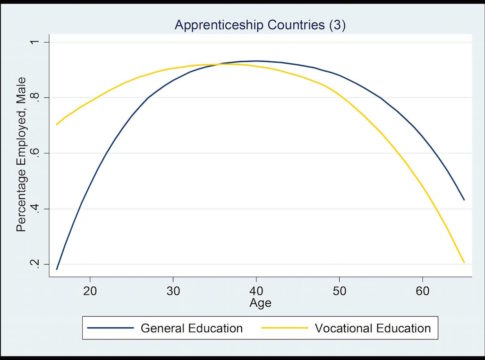
Earlier this month the Trump administration declared a “workforce development week.” The president is promising to make a big push on apprenticeships. During a cabinet meeting, he said, “Apprenticeships are going to be a big, big factor in our country.”
The vast majority of Americans don’t get jobs via apprenticeships, so the public, and even many employers, don’t know much about them. As Eric Morath wrote for the WSJ, compared to European countries, the US underutilizes apprenticeships—even though, according to the US Department of Labor, “nine in 10 Americans who complete apprentice training land a job, and their average starting salary is $60,000 a year.”
Apprenticeships typically take the form of an employer and some type of education provider teaming up to offer hands-on training to prospective workers. Most apprenticeships are government certified. Importantly, apprenticeships are paid (unlike the typical internship), making them attractive to older workers who can’t go without an income and younger workers hoping to avoid borrowing for further education.
Apprenticeships are especially popular among policymakers at the moment because of our national labor force-participation and skills-gap challenges. Millions of able-bodied Americans have dropped out of the workforce even though employers report that millions of jobs sit unfilled for want of properly trained employees. Politico recently referred to apprenticeships as the “rare policy tool that enjoys bipartisan support.”
The administration put on a multi-day full-court press: highlighting apprenticeships at Monday’s cabinet meeting; visiting a technical school on Tuesday; on Wednesday, a meeting with CEOs and then a major speech at the Department of Labor; finally a roundtable with governors on Thursday.
But as with many Trump administration ideas, the devil’s in the details… or actually in the lack of details. It’s still not entirely clear what the “it” is. His proposed budget reduced funding for a number of education and training programs, and according to the Washington Post, he’s “reluctant to devote more taxpayer money to the effort.”
Politico reported that a senior administration official said, “The problem is not money…the problem is [training programs] haven’t been set up in an effective and accountable way.” Labor Secretary Alex Acosta suggested the initiative may focus on partnerships between employers and higher education. Reporting by the Chronicle of Higher Education suggested it would focus on accreditation and student aid. A CBS News article suggests the initiative would be mostly about reorganizing existing federal workforce programs.
So what are possible downsides of apprenticeships? One is cost; there are nontrivial expenses associated with educating someone for a job. Obviously, employers will be wary in that investment if those trained end up taking those skills elsewhere. One question relates to education providers; who should deliver training—high schools, community colleges, unions, nonprofits, for-profits, employers? And assuming the government provides funding, how should providers be held accountable?
One final consideration was ably explained in a recent blog post by Kate Kreamer of Advance CTE about a new international study of career and technical education programs. The Hanushek et al. paper finds evidence for a widespread worry about training high school students for specific jobs: the benefits of that training wear off because the skills become outdated, the industry weakens, or the jobs get replaced. The implication is that such students, even though they benefit from CTE early in their careers, fall behind in the long term; those who had a more general high school curriculum or went to college would reap career-long benefits. The authors believe they’ve found “a clear tradeoff between early career employment and employment later in the lifecycle.”
As Kreamer notes, however, the US has taken a different approach than many European nations—one that might benefit us. Though many laud the German apprenticeship model that directs many young people into industry-specific training, the US hasn’t gone down that path for the most part. We’re generally averse to “tracking” (deciding early in secondary education who’s right for college and who’s right for work), so our state policies generally view CTE as an “add on” to, not a replacement for, a traditional high school education. Successful CTE programs, Kreamer writes, are “not focused on short-term labor market needs – although they may fill them – but rather on the lifetime success of their students.” So while international approaches to apprenticeships can be promising, Kraemer smartly notes that the study amounts to a “cautionary tale of focusing on the short-term needs of an economy when designing a career preparation system.”
In other words, an apprenticeship might be great for landing a job, but a fuller education might be indispensable for a lifetime of successful work.
— Andy Smarick
Andy Smarick is a resident fellow at the American Enterprise Institute. This post originally appeared on AEIdeas.





